As I mentioned in the first part, there are individuals who are truly artists in the creativity which they bring to the production of crystal images. For me, the enterprise is rather different. I am indeed interested in some of the beautiful forms which experiments with crystals can produce but, for me, this activity is often a form of serious play (and, no, that’s not an oxymoron). I should add a note here that all of the images in this essay are taken with polarized light. Not infrequently, I come across a view of some crystals through the microscope and immediately “see” an identifiable form or one that can be brought out with a bit of computer processing, such as, altering the background to emphasize the central content. I’ll give you an example of such here–an ancient fish.

This is the image before I “worked it over”. To me it immediately appeared as fish embedded in a bunch of clutter. So, I saw my task as that of “rescuing” it. Now, you might look at it and say: “Absurd! There’s no fish there; what have you been drinking? And do you have any extra you’re willing to share?”
Well, I admit that I did do some fairly radical surgery on the image, adding a background and using that as a means to eliminate the “clutter”. Here’s the result of the operation.

See, what did I tell you?–an ancient fish and a colorful one at that.
Some are even more obvious and there is little room for dispute if your projective instincts are working properly. Consider this next image; it clearly is leaves, perhaps of a fern, although more colorful than the ferns we find in our gardens. This image is from a mixture of the cytological stain Orange G and Ascorbic acid and on this particular slide, I used a cover glass.

This kind of pattern projection or what is called pareidolia is defined by Wikipedia as:
Pareidolia is the tendency for perception to impose a meaningful interpretation on a nebulous visual stimulus (so that one sees an object, pattern or meaning where in fact there is none).
Now, this seems to be quite a nasty, mean-spirited definition obviously concocted by some senile curmudgeon. It also is epistemologically highly dubious, so we’ll ignore such academic nonsense and proceed with our serious play.
Another example which I regard as quite reasonable relative to my description is one I have labeled as “Lichen with Red Moss”. It is also a mixture of Orange G and Ascorbic acid.

Now, admittedly, some of my “interpretations” are highly fanciful, but I can’t be stodgy all the time. This next example is indeed rather “free-wheeling” and I call it “Alien Sleepwalking”. Surprisingly, this came from the same Orange G and Ascorbic acid slide that produced the two previous images.

Another intriguing example from the same slide is one which I call “Sponge Sporangia”. First I’ll show you my image.

Next, an image from Google of genuine sponge sporangia.

And, now, (trumpet fanfare), my computer modification of my original image to approximate more closely, the image from Google. I have neither the patience nor the skill to do a very precise alteration, but you must admit that it’s not too far off the genuine sporangia.

Many times, however, rather than engaging my special neural nets for pareidolia, my own brand of artificial intelligence, I simply label images I like as “Abstract”. Guess what; this next image is labeled “Abstract 1". This is a crystallization of a solution of Anbesol, a liquid toothache pain medication, using a cover glass.

Some images I find quite intriguing to examine with minimum processing and simply enjoy their abstract form. The one below is an example. This is a more complex mixture involving Strontium chloride and Potassium acetate.

The black spaces strike me as the kind of abstract forms that one might find in the paintings of Miro or the mobiles of Calder or the paintings and sculpture of Hans Arp. I suppose one might think of them as lagoons and the “sandy” areas as beaches with ancient swords and arrows lying on them. Oh, no, I can’t escape the pareidolia; perhaps I need to see an image therapist or an imaginary one.
And while we’re in a playful mood, I present to you an image titled: “A Distant Circus”. The crystals are from Strontium chloride.

In the distance we see a wooden cliff and from left to right, a leaping clown, an acrobat standing on his head, and a rearing horse.
Coming up next for your delectation is a “Feather Fish” which, as you can readily see, is a close relative of the Lion Fish. Here we have an interesting mixture of Thiourea and Sodium acetate, this latter having been used as an egg preservative before refrigeration became widely available.

Another image from the same slide is one which is readily viewed as an aquarium.
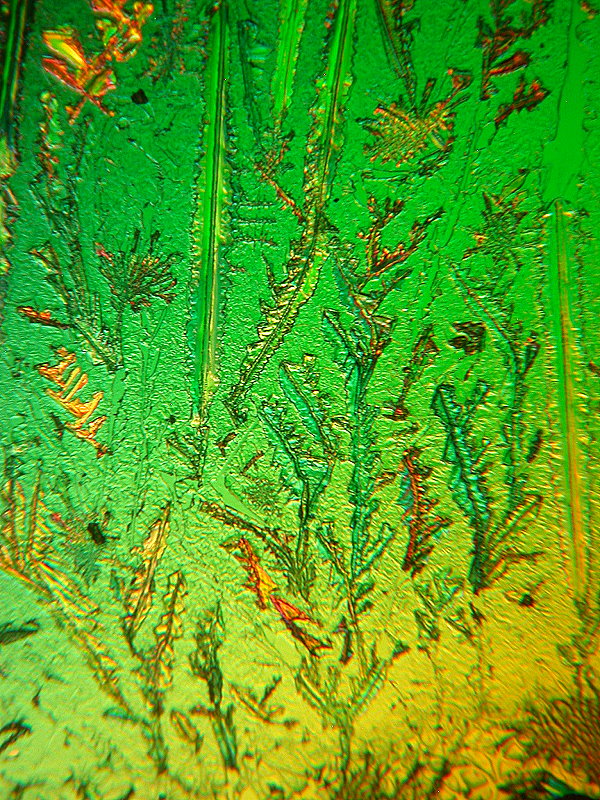
Another image which requires little interpretation has quite a different provenance; it is a mixture of Ascorbic acid and a dilute solution of Iodine and presents itself very nicely as a flower.
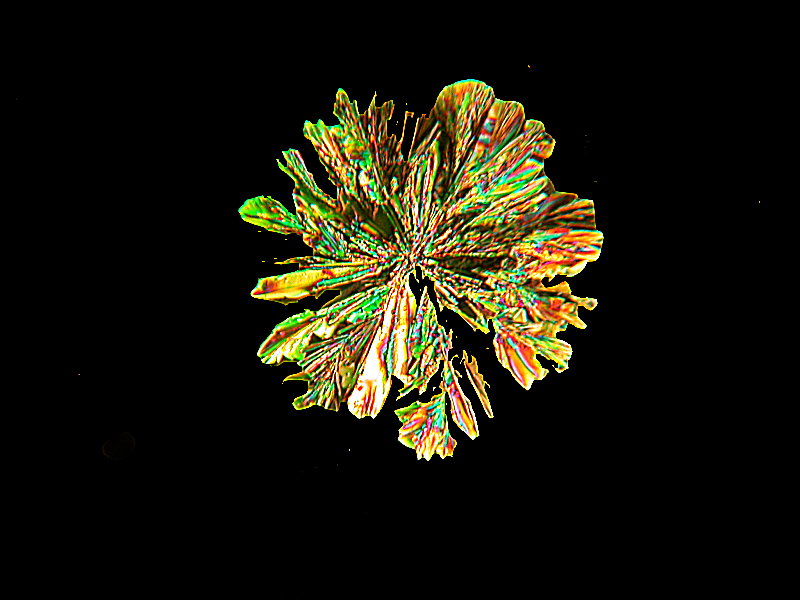
Now, a quick, brief shift in gears to another fanciful image which I call “Thistle Seeds”; it is a combination of Thiourea and Bromoseltzer. Bromoseltzer is no longer available under its old formulation as it was discovered that bromine salts had cumulative toxic effects and so it was eventually banned.

The next two images are essentially abstractions and apart from cleaning up the clutter in the background a bit, these two remain unmodified. The first I call “Swirls” for obvious reasons.
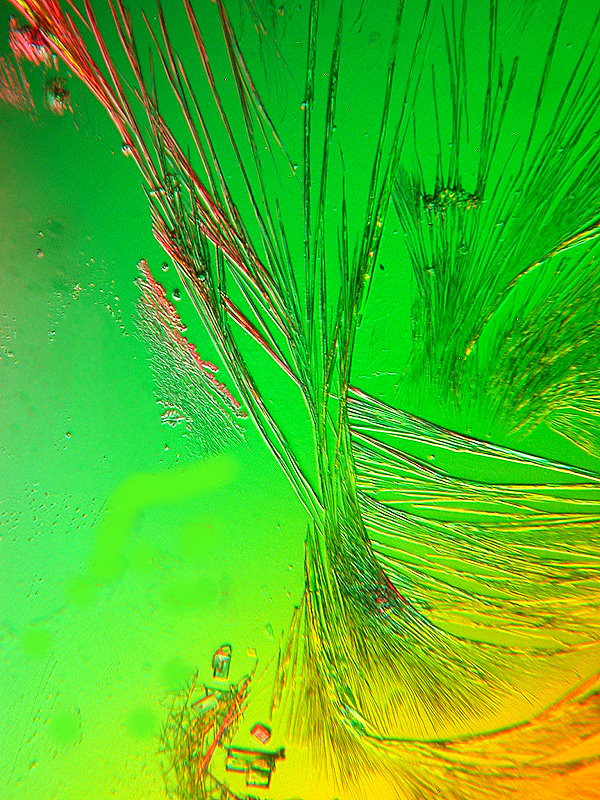
The second image is simply labeled “Angles”. It is a mixture of Strontium chloride and Quinine sulfate for your Gin and Tonics to help counteract those vicious malaria mosquitos.
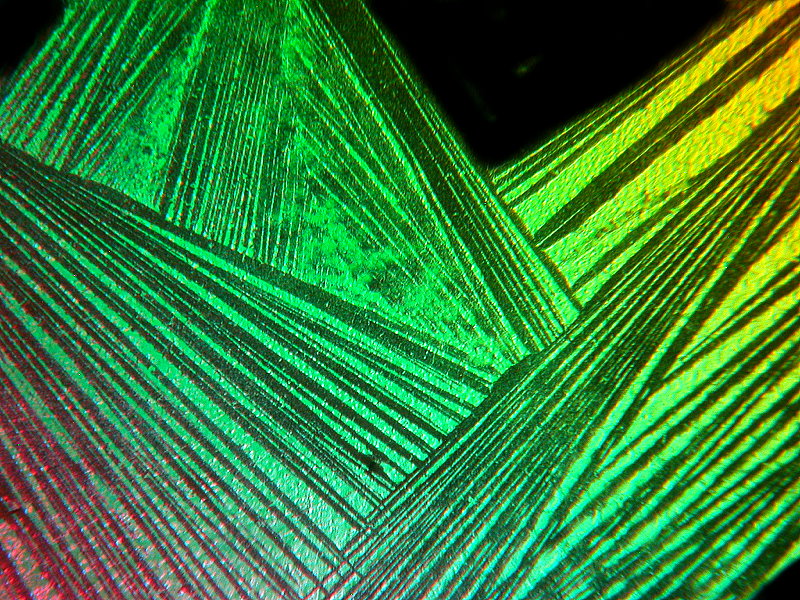
As if we don’t already have enough sources of allergies in nature, I was able to generate some crystalline ragweed, which you can view below. It’s a mixture of Potassium acetate and Urea.
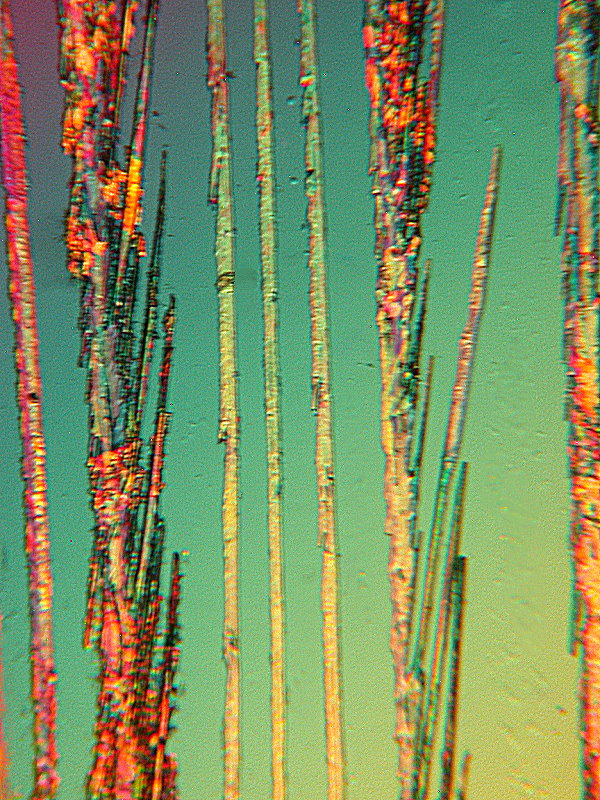
Many crystals are erratic in the ways that they deposit material and grow. However, some, blessedly, are predictable in the kinds of patterns which they will provide for us. Others, may have a repertoire giving us several types of possible patterns; ascorbic acid is a good example as it produces disks, Maltese crosses, thin quasi-circular, concentric formations (often visible only at relatively high magnifications), and occasional clusters of disks that form interesting patterns of their own.
However, here, I want to deal with a different chemical, namely, Manganese chloride. This substance quite consistently, on its own when not mixed with other chemicals, produces lovely patterns of leaf-like clusters. I will show you two images which are quite archetypical.
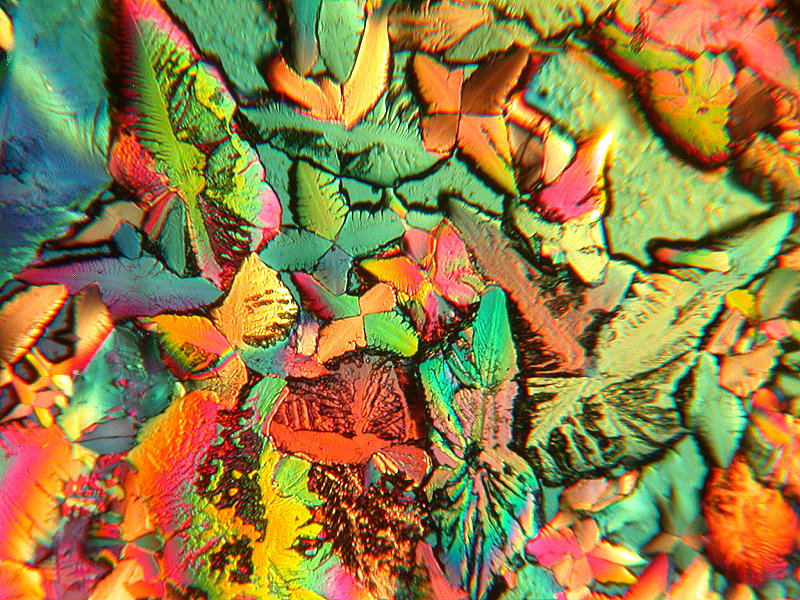
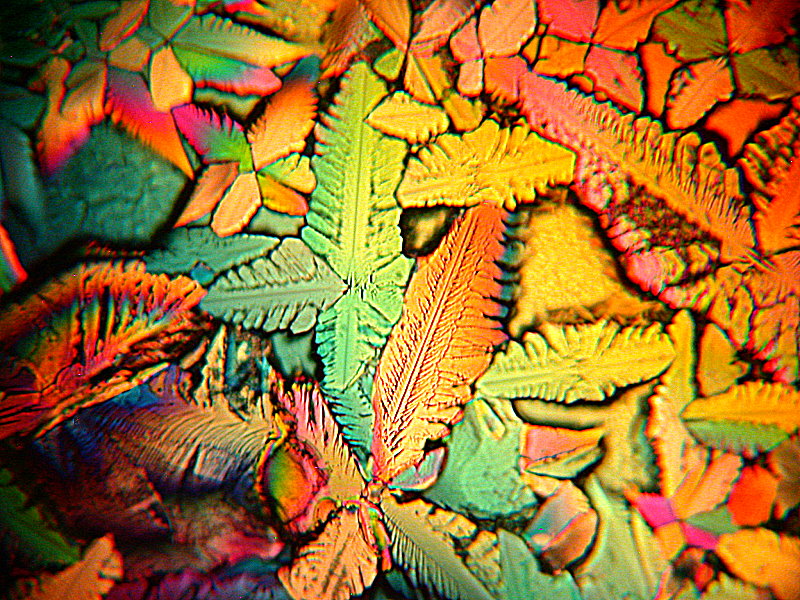
How about some more fish; this time some flying ones. I found this image quite fishy and couldn’t resist interpreting as such.
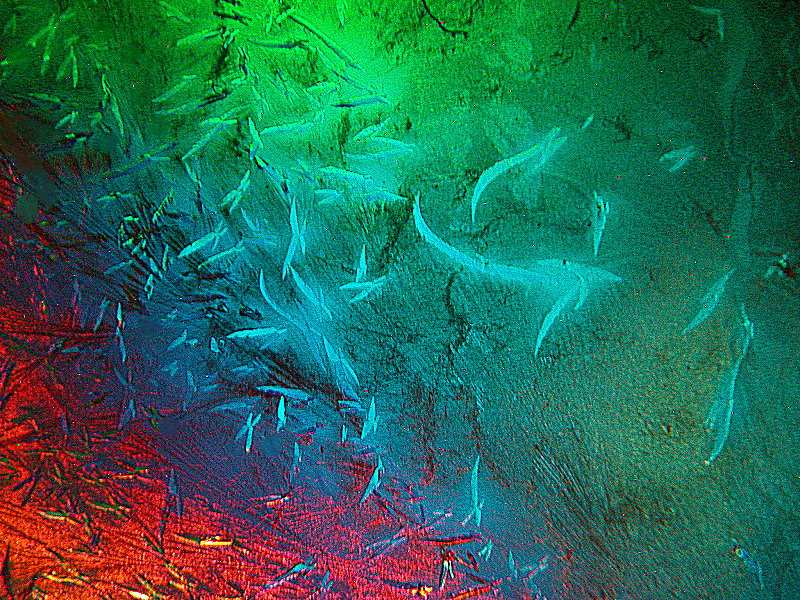
Since we’re looking at marine critters, I have a couple of others for you to examine. The first is a stingray and is a mixture of Dextrose and Sodium chloride or, in other words, sugar and salt like the mixture you might find on certain new marketing trends in chips and pretzels.
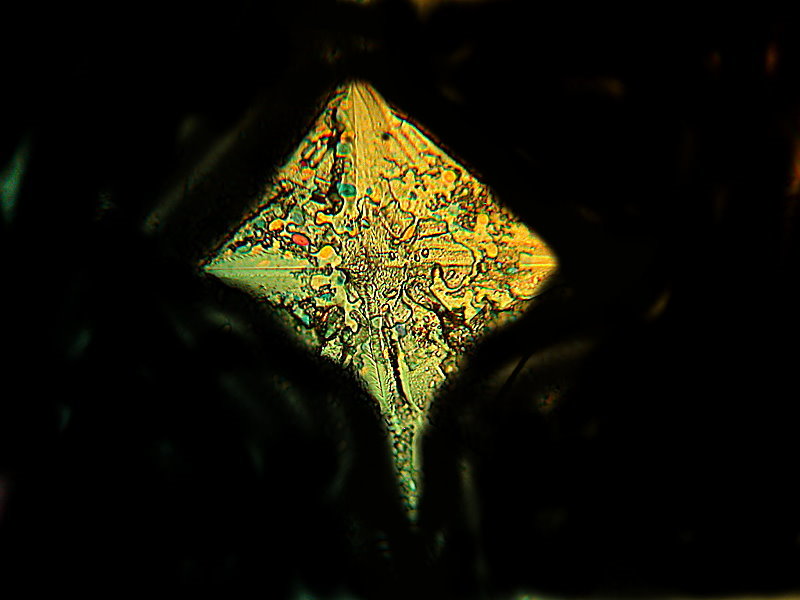
Next up, a fish within a fish. Here we have an image of a small fish still in the mouth of a bigger abyssal fish and if the spine on top of the head or the one below the jaw, is flexible, it could even be an anglerfish.
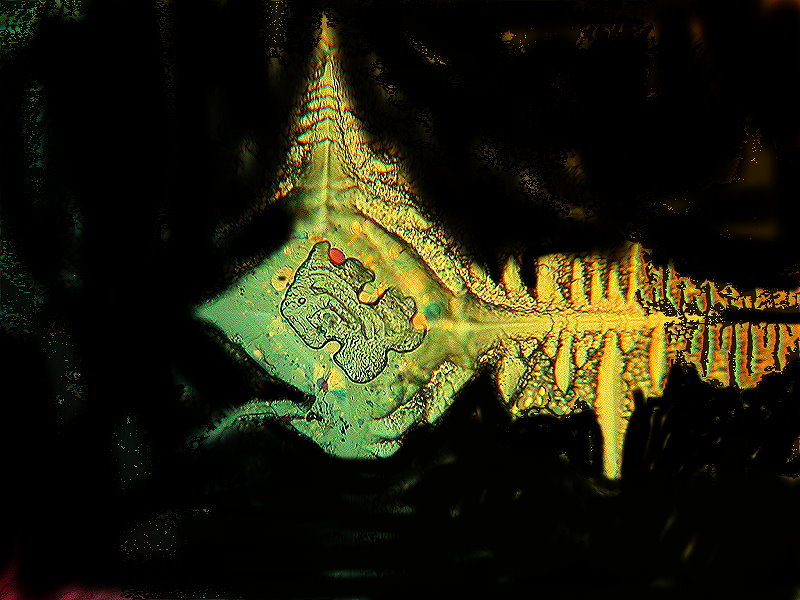
Hang in there, we’re almost done. I mentioned earlier that Ascorbic acid can produce sets of concentric circles consisting of very thin lines. Well, here we have three examples that show that characteristic quite clearly. For the first one, the filters were set to produce a monochromatic green image and the black quasi-circles show up quite clearly in this disk. The surrounding fuzzy context for the disk is likely a consequence of the fact that this slide was prepared using heated solution of Ascorbic acid.
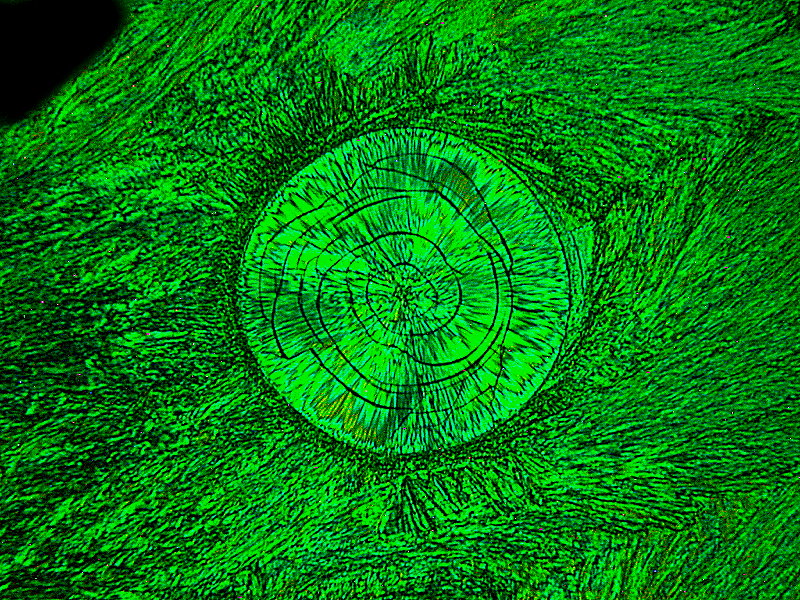
The next image formed as just a portion of a disk and looks rather like a fan. Again the lines are quite clearly visible.
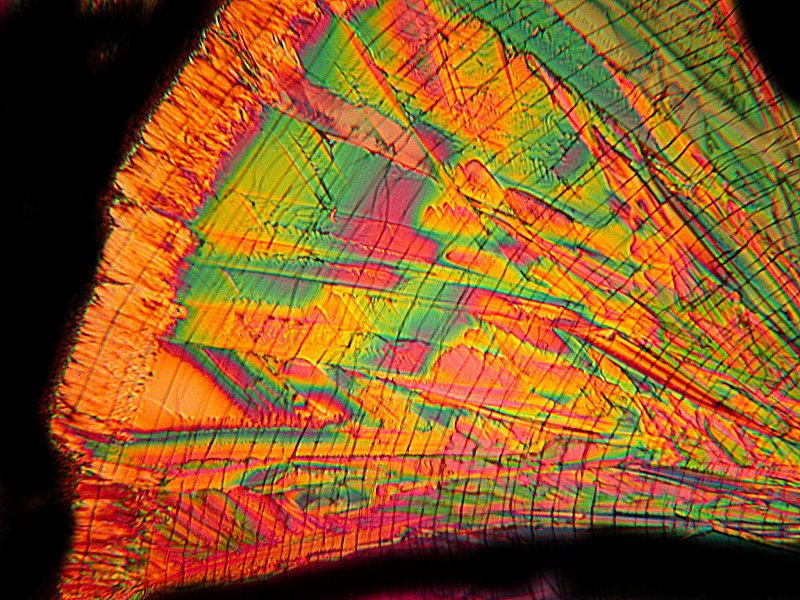
And finally, I will get a bit fanciful for this last image which I have labeled as “A Bird Eating a Spider Web”. I think that says it all.
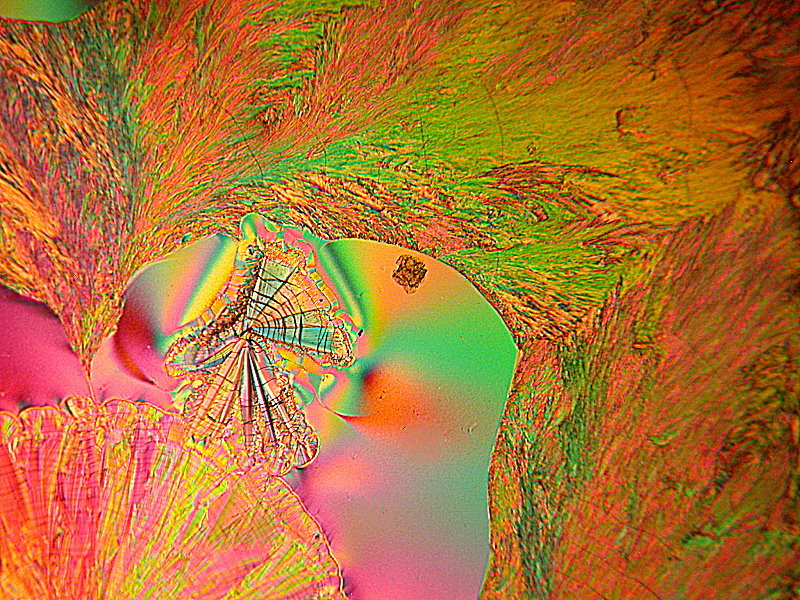
So, go try out some crystal making, experiment, play, and above all enjoy. However, as always, be cautious about what you mix; know in advance any potential risks, so that you can work safely.
If I can overcome my laziness, I might try to put together a third part in which I use a variety of computer techniques on just a very few images in order to explore the fun possibilities of image alteration. If, on the other hand, you don’t under any circumstances, want a Part 3, then the surest way to prevent it is to send in articles of your own to Micscape. I know, it’s spring sliding into summer and you’re busy, but this is also the time when the best pond collecting is possible and surely, you can find some interesting critters to write about. So, get to it and give Dave Walker lots of new material for all of us to enjoy.
Acknowledgment
I wish to thank Sawyer Winn, a student assistant, who has prepared many of the slides for these images and for the previous article on crystal images as well. We tried a wide range of combinations and were able to achieve some rather good results.
A Plea
Micscape is a wonderful place to try out and share ideas and it is open to amateurs and professionals alike. Please consider sending notes, images, articles, or even a picture of your favorite slide telling why in just few sentences, or ten pages, if you like. Dave Walker is a wonderful editor who is very helpful if you have questions about format, organization of an article, or virtually anything that you might want to submit. MICSCAPE depends upon its contributors to help stimulate interest in microscopy and encourage both young and old to investigate the endless mysteries of Nature. So, please do send lots and lots and quit putting it off and forgetting about it.
All comments to the author Richard Howey
are
welcomed.
If email software is not linked to a browser, right click above link and use the copy email address feature to manually transfer.
Editor's note: Visit Richard Howey's new website at http://rhowey.googlepages.com/home where he plans to share aspects of his wide interests.
Microscopy UK Front
Page
Micscape
Magazine
Article
Library
© Microscopy UK or their contributors.
Published in the September 2021 edition of Micscape Magazine.
Please report any Web problems or offer general comments to the Micscape Editor .
Micscape is the on-line monthly magazine of the Microscopy UK website at Microscopy-UK .
©
Onview.net Ltd, Microscopy-UK, and all contributors 1995
onwards. All rights reserved.
Main site is at
www.microscopy-uk.org.uk .